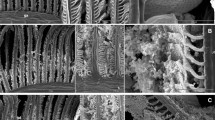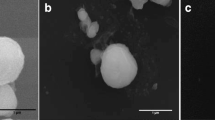Abstract
Water is an essential factor for maintaining the vital functions of living beings. Nickel is the 24th most abundant element on Earth; it is a heavy metal that is genotoxic and mutagenic in its chloride form. Due to industrial use, its concentration in surface sediments increased considerably. Fish develop characteristics that make them excellent experimental models for studying aquatic toxicology. They are particularly useful because they can alert of the potential danger of chemical substances or environmental pollution. Due to water quality impairment and because there are few published studies that relate nickel to tissue alteration, this study aimed to examine the consequences of nickel in an aquatic environment. For this analysis, individuals of Oreochromis niloticus were exposed for 96 h to three different concentrations of nickel dissolved in water according to the standard established by Brazilian law and compared them to a control group. After exposure, the gills were analyzed using X-ray microanalysis, ultramorphology, and histological and histochemical analysis. The results demonstrated that all the concentrations used in the experiment altered the histophysiology of the individuals exposed. In conclusion, the nickel presents a toxic potential to fish, even at the lowest concentration tested, which is equivalent to half of the concentration allowed by law. The CONAMA resolution should be revised for this parameter because of the interference of this metal in the histophysiology of the tested organism.




Similar content being viewed by others
References
Alves-Costa JRM (2001) Biomarcadores de contaminação em peixes de água doce, por contaminação em chumbo (II): ensaios laboratoriais com Hoplias malabaricus e Oreochromis niloticus. Dissertação, Universidade Federal do Paraná, (in Portuguese)
Arellano JM, Storch V, Sarasquete C (1999) Histological changes and copper accumulation in liver and gills of the Senegales Sole, Solea senegalensis. Ecotoxicol Environ Safety 44:62–72
Ateeq B, Abul Farah M, Niamat A, Wassem A (2002) Induction of micronuclei and erythrocyte alterations in the catfish Clarias batrachus by 2,4-dichlorophenoxyacetic acid and butachlor. Mutat Res 518:135–144
Bernet D, Schmidt H, Meier W, Burkhardt-Holm P, Wahli T (1999) Histopathology in fish: proposal for a protocol to assess aquatic pollution. J Fish Dis 22:25–34
Biagini FR, David JAO, Fontanetti CS (2009) The use of histological, histochemical and ultramorphological techniques to detect gill alterations in Oreochromis niloticus reared in treated polluted waters. Micron 40:839–844
Brix KV, Keithly J, Deforest DK, Laughlin J (2004) Acute and chronic toxicity of nickel to rainbow trout (Oncorhynchus mykiss). Environ Toxicol Chem 23:2221–2228
Cerqueira CCC, Fernandes MN (2002) Gill tissue recovery after copper exposure and blood parameter responses in the tropical fish Prochilodus scrofa. Ecotoxicol Environ Saf 52:83–91
Chowdhury MJ, Bucking C, Wood CM (2008) Pre-exposure to waterborne nickel downregulates gastrointestinal nickel uptake in rainbow trout: indirect evidence for nickel essentiality. Environ Sci Technol 42:1359–1364
David JAO, Salaroli RB, Fontanetti CS (2008) The significance of changes in Mytella falcata (Orbigny, 1842) gill filaments chronically exposed to polluted environments. Micron 39:1293–1299
Evans DH (1987) The fish gill: site of action and model for toxic effects of environmental pollutants. Environ Health Perspect 71:47–58
Exley C, Chappell JS, Birchall JD (1991) A mechanism for acute aluminium toxicity in fish. J Theor Biol 151:417–28
Fanta E, Rios FS, Romão S, Vianna ACC, Freiberger S (2002) Histopathology of the fish Corydoras paleatus contaminated with sublethal levels of organophosphorus in water and food. Ecotoxicol Environ Safety 54:119–130
Fontanetti CS, Souza TS, Christofoletti CA (2012) The role of biomonitoring in the quality assessment of water resources. In: Bilibio C, Hensel O, Selbach J (eds) Sustainable water management in the tropics and subtropics—and cases study in Brazil. UNIPAMPA/UNIKASSEL, Brasil/Alemanha, pp 975–1005
Ikem A, Egiebor NO, Nyavor K (2003) Trace elements in water, fish and sediment from Tuskegee Lake, south-eastern USA. Water Air Soil Pollut 149:51–75
Junqueira LCU, Junqueira MMS (1983) Técnicas básicas de citologia e histologia. Livraria Editora Santos, São Paulo, (in Portuguese)
Karnovsky MJ (1965) A formaldehyde-glutaraldehyde fixative at high osmolarity for use in electron microscopy. J Cell Biol 11:137–140
Kasprzak KS (1987) Nickel. Adv Mod Environ Toxicol 11:145–183
Kikuchi M, Wakabayashi M, Kojima H, Yoshida (1978) Uptake, distribution and elimination of sodium linear alkylbenzene sulfonate and sodium alkyl sulfate in carp. Ecotoxicol Environ Safety 2:115–127
Koca S, Koca YB, Yildiz S, Gurcu B (2008) Genotoxic and histopathological effects of water pollution on two fish species, Barbus capito pectoralis and Chondrostoma nasus in the Büyük Menderes River, Turkey. Biol Trace Elem Res 122:276–291
Laurent P, Perry SF (1991) Environmental effects on fish gill morphology. Physiol Zool 64:4–25
Mallat J (1985) Fish gill structural changes induced by toxicants and other irritants: a statistical review. Can J Fish Aquat Sci 42:630–648
Mansouri B, Ebrahimpour M, Babaei H (2012) Bioaccumulation and elimination of nickel in the organs of black fish (Capoeta fusca). Toxicol Ind Health 28:361–8
Martinez CBR, Nagae MY, Zaia CTBV, Zaia DAM (2004) Acute morphological and physiological effects of lead in the neotropical fish Prochilodus lineatus. Braz J Biol 64:797–807
Mckim JM, Erickson RJ (1991) Environmental impacts on the physiological mechanisms controlling xenobiotic transfer across fish gills. Physiol Zool 64:39–67
Mishra V, Lal H, Chawla G, Viswanatan PN (1985) Pathomorphological changes in the gills of fish fingerlings (Cirrhina mingala) by lineal alkylbenzene sulfonate. Ecotoxicol Environ Safety 10:302–308
Otitoloju AA, Elegba OK, Osibona AO (2009) Biological responses in edible crab, Callinectes amnicola that could serve as markers of heavy metals pollution. Environmentalist 29:37–46
Pane EF, Mcdonald MD, Curry HN, Blanchard J, Wood CM, Grosell M (2006) Hydromineral balance in the marine gulf toadfish (Opsanus beta) exposed to waterborne or infused nickel. Aquat Toxicol 80:70–81
Perry SF, Laurent P (1993) Environmental effects on fish gill structure and function. In: Rankin JC, Jensen FB (eds) Fish ecophysiology. Chapman & Hall, London, pp 231–264
Powers DA (1989) Fish as model systems. Science 246:352–358
Randi AS, Monserrat JM, Rodriguez EM, Romano LA (1996) Histopathological effects of cadmium on the gills of the freshwater fish, Macropsobrycon uruguayanae Eigenmann (Pisces, Atherinidae). J Fish Dis 19:311–322
Rankin JC, Atagg RM, Bolis L (1982) Effects of pollutants on gills. In: Huolihan DF, Rankin JC, Shuttleworth TJ (eds) Gills. Cambridge University Press, New York, pp 207–220
Romeoa M, Siaub Y, Sidoumou Z, Gnassia-barelli M (1999) Heavy metal distribution in different fish species from the Mauritania coast. Sci Total Environ 232:169–175
Sze PWC, Lee SY (1995) The potential role of mucus in the depuration of copper from the mussels Perna viridis (L.) and Septifer virgatus (Wiegmann). Mar Pollut Bull 31:390–393
Takashima F, Hibiya T (1995) An atlas of fish histology: normal and pathological features. Kodanska/Stuttgart. Fischer Verlag, Tokyo
Tjälve H, Borg-Neczak K (1994) Effects of lipophilic complex formation on the disposition of nickel in experimental animals. Sci Total Environ 148:217–242
Vijayan MM, Morgan JD, Sakamoto T, Grau EG, Iwana GK (1996) Food deprivation effects seawater acclimation in tilápia: hormonal and metabolic changes. J Exp Biol 199:2467–2475
Wendelaar Bonga SE, Lock RAC (1991) Toxicants and osmoregulation in fish. Neth J Zool 42:478–493
Wong CK, Wong M (2000) Morphological and biochemical changes in the gills of tilapia (Oreochromis mossambicus) to ambient cadmium exposure. Aquat Toxicol 48:517–527
Acknowledgment
This research was supported by CNPq (National Council for Scientific and Technological Development) and FAPESP (São Paulo Research Foundation) process n. 2011/14881-3. The authors would like to thank Prof. Dr. José Carlos Marconato for contributing to the dilution calculations of the nickel used and the researchers Annelise Francisco, Jorge E. Correia, Júlia F. U. Marinho, and Larissa R. Nogarol for their help during the collections.
Author information
Authors and Affiliations
Corresponding author
Additional information
Responsible editor: Thomas Braunbeck
Rights and permissions
About this article
Cite this article
Marcato, A.C.C., Yabuki, A.T. & Fontanetti, C.S. Nickel exposure promotes osmoregulatory disturbances in Oreochromis niloticus gills: histopathological and energy dispersive spectrometry analysis. Environ Sci Pollut Res 21, 13095–13102 (2014). https://doi.org/10.1007/s11356-014-3248-2
Received:
Accepted:
Published:
Issue Date:
DOI: https://doi.org/10.1007/s11356-014-3248-2




